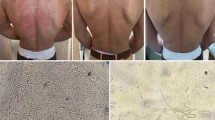Abstract
Objevtive: Terbinafine is an antifungal drug known to have also antibacterial activity against certain Gram-positive and Gram-negative bacteria. It seems that antibacterial and antifungal activity of terbinafine may have an advantage in the treatment of mixed fungal and bacterial superficial skin infections. Nevertheless, clinical relevance of the antibacterial part of its action has not been investigated efficiently. To compare the efficacy and safety of terbinafine with those of mupirocin, which has already proven antibacterial action, in the treatment of impetigo.Methods: Children clinically diagnosed as having impetigo were treated with topical mupirocin or topical terbinafine in a randomized fashion. Patients’ lesions were examined clinically on days 0,4, 7,10 and bacteriologic cultures were obtained on days 0 and 10.Results: A total of 62 patients were included in the study. Forty-eight of these patients were eligible for the efficacy and safety analysis. Twenty-five and 23 patients were treated with mupirocin and terbinafine, respectively. The clinical cure rates were 100% for the mupirocin group and 70% for the terbinafine group (p< 0.05). The bacteriological eradication rate for mupirocin-treated children was 100% and that for terbinafine-treated children was 78%(p< 0.05). Presence of bullous lesions appeared to be a factor for poor clinical outcome in the terbinafine group. Mild local adverse effects were noted in a small percentage of patients in each group.Conclusion : Antibacterial activity of terbinafine is not strong enough to be an alternative in the treatment of impertigo. It is advisable that terbinafine could be used in combination with an antibacterial drug for superficial skin enfections caused by both fungi and bacteria.
Similar content being viewed by others
References
Ryder NS, Favre B. Antifungal activity and mechanism of action of terbinafine.Rev Contemp Pharmacother 1997; 8: 275–287.
Nolting S, Brautigam M. Clinical relevance of the antibacterial activity of terbinafine: A contralateral comparison between 1% terbinafine cream and 0.1% gentamicin sulphate cream in pyoderma.Brt J Dermatol 1992; 126^(Suppl. 39): 56–60.
Faergemann J. Pharmacokinetics of terbinafine.Rev Contemp Pharmacother 1997; 8: 289–297.
Dagan R, Bar-David Y. Double-blind study comparing erythromycin and mupirocin for treatment of impetigo in children: Implications of a high prevalence of erythromycin-resistant Staphylococcus aureus strains.Antimicrob Agents Chemother 1992; 36: 287–290.
Britton JW, Fajardo JE, Crafte-Jacobs B. Comparison of mupirocin and erythromycin in the treatment of impetigo.J Pediatr 1990; 117: 827–829.
Dux PH, Fields L, Pollock D.2% topical mupirocin versus systemic erythromycin and cloxacillin in primary and secondary skin infections.Curr Ther Res 1986; 40: 933–940.
Bass JW, Chan DS, Creamer KM, Thompson MW, Malone FJ, Becker TM, Marks SN. Comparison of oral cephalexin, topical mupirocin and topical bacitracin for treatment of impetigo.Pediatr Infect Dis J 1997; 16: 708–710.
Welsh O, Saenz C. Topical mupirocin compared with oral ampicillin in the treatment of primary and secondary skin infections.Curr Ther Res 1987; 41:114–120.
White DG, Collins PO, Rowsell RB. Topical antibiotics in the treatment of superficial skin infections in general practice-a comparison of mupirocin and sodium fusidate.J Infect 1989; 18: 221–229.
Leyden JJ, Kligman AM. Interdigital athlete’s foot. The interaction of dermatophytes and resident bacteria.Arch Dermatol 1978; 114:1466–1472.
Brook I. Microbiology of secondarily infected diaper dermatitis.Int J Dermatol 1992; 31: 700–702.
Arredondo JL. Efficacy and tolerance of topical mupirocin compared with oral didoxacillin in the treatment of primary skin infections.Curr Ther Res 1987; 41:121–127.
Suhonen R, Neuvonen PJ. The tolerability profile of terbinafine.Rev Contemp Pharmacother 1997; 8: 373–386.
Author information
Authors and Affiliations
Corresponding author
Rights and permissions
About this article
Cite this article
Ciftci, E., Guriz, H. & Aysev, A.D. Mupirocin vs terbinafine in impetigo. Indian J Pediatr 69, 679–682 (2002). https://doi.org/10.1007/BF02722704
Issue Date:
DOI: https://doi.org/10.1007/BF02722704




